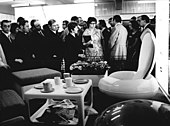Peter Ghyczy
After the invasion of the Red Army 1945, in which his father was killed, he was sent to the family's property Vásárosnameny in the Puszta plains, where he also visited the village school.
In 1968 he took a leading position at the company Elastogran in Lemförde in southern Lower Saxony, where he was responsible for the development of products made from polyurethane.
Owner of the company Gottfried Reuter, former chemist at Bayer in Leverkusen, was an expert in the field of polyurethane production, for which he held several patents.
[citation needed] In 1970 the Design-Center in Lemförde was inaugurated, built according to Ghyczy's design, made completely from polyurethane and being the first of its kind.
[citation needed] This design studio gave birth to many novel, modular components, such as shelters, facade elements but most notably various types of furniture, among them chairs, shell chairs, sectional sofas, tables, shelves and plastic door fronts for offices and kitchens.Licenses were given to well-known companies, among others Drabert, "die Vereinigten Werkstätten", Vitra (at the time still named Fehlbaum GmbH), and Beylarian in the USA.
After the fall of the "iron curtain" it made a reappearance as "Senftenberger Ei" - often falsely seen as an East German design - in the art scene of the late 90s, where it turned into a highly desired collector's item, Peter Ghyczy now produces his own re-edition.
[citation needed] Peter Ghyczy designed numerous lamps, for example the series MegaWatt and the table lamp MW 17, a curved, balanced tabular steel Rohr; another "frameless" construction - an idea, which resembles a famous piece in design history, the "legless" "Freischwinger" presented by Mart Stam and Ludwig Mies van der Rohe in 1927.


